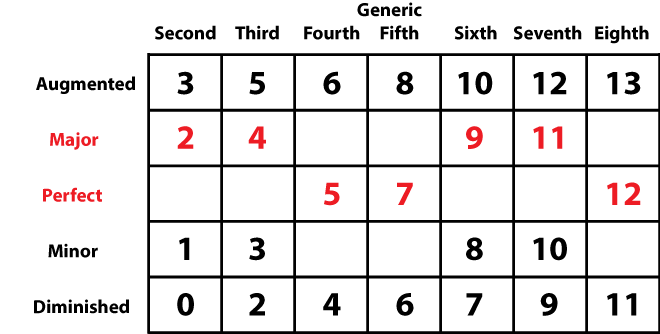Music Intervals
An interval is the distance between two musical notes. When learning to write music intervals, you need to know the two kinds of intervals: Generic intervals and Specific Intervals
Generic Intervals (Simple Intervals)
Generic intervals (or simple intervals) are the distance between two notes measured on the staff:

first (prime) | second | third | fourth | fifth | sixth | seventh | eighth are the names of the generic intervals.
*Accidentals are ignored when counting the number of generic intervals.
Seconds, thirds, sixths, and sevenths can have a major or minor quality. Firsts, fourths, fifths, and eighths have a perfect quality. All intervals can have an augmented or a diminished (except prime) quality.
prime (perfect | augmented)
second (major | minor | augmented | diminished)
third (major | minor | augmented | diminished)
fourth (perfect | augmented | diminished)
fifth (perfect | augmented | diminished)
sixth (major | minor | augmented | diminished)
seventh (major | minor | augmented | diminished)
eighth (perfect | augmented | diminished)
Specific Intervals
Specific intervals are the distance between two musical notes measured in half steps on the keyboard.
In other words, specific intervals are defined by the number of half steps between the two notes on the keyboard.
This table shows the number of half steps for each specific interval.

Major / Perfect Quality Intervals
First, let’s look at the major / perfect quality. These numbers are highlighted in red.
Major second: 2 half steps
Major third: 4 half steps
Perfect fourth: 5 half steps
Perfect fifth: 7 half steps
Major sixth: 9 half steps
Major seventh: 11 half steps
Perfect eighth: 12 half steps
Minor Quality Intervals
Minor = Major – 1
Minor second: 1 half steps
Minor third: 3 half steps
Minor sixth: 8 half steps
Minor seventh: 10 half steps
Minor intervals transform from major intervals, so only seconds, thirds, sixths, and sevenths can be minor.
Augmented Quality Intervals
Augmented = Perfect + 1
or
Augmented = Major + 1
Augmented second: 3 half steps
Augmented third: 5 half steps
Augmented fourth: 6 half steps
Augmented fifth: 8 half steps
Augmented sixth: 10 half steps
Augmented seventh: 12 half steps
Augmented eighth: 13 half steps
If an interval is a half-step larger than a perfect or a major interval, it is called augmented.
Diminished Quality Intervals
Diminished = Perfect – 1
or
Diminished = Minor – 1
Diminished second: 0 half steps
Diminished third: 2 half steps
Diminished fourth: 4 half steps
Diminished fifth: 6 half steps
Diminished sixth: 7 half steps
Diminished seventh: 9 half steps
Diminished eighth: 11 half steps
An interval that is a half-step smaller than a perfect or a minor interval is called diminished.
How to write intervals on the staff?
Here is an example:
Diminished Fifth above E

Steps to writing intervals on the staff:
1. Write the E note on the staff.
2. Write the generic fifth from E on the staff.
3. From the interval table, find the number of half steps for diminished fifth.
4. Raise 6 half steps from E on the keyboard.
5. Six half steps from E is B Flat.

How to identify and name intervals?
Example:

Steps to naming intervals:
1. Ignore any accidental & count the generic intervals on the staff.
This example is a generic sixth on the staff. Sixths can have a major, minor, diminished or augmented quality.
2. Count the number of half steps from C to A Flat on the keyboard.
There are 8 half steps from C to A Flat.
3. From the interval table, look at the generic sixth column and find the name of the interval with 8 half steps.
Minor sixth is the name of this interval.
